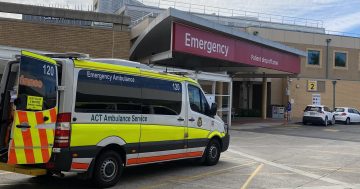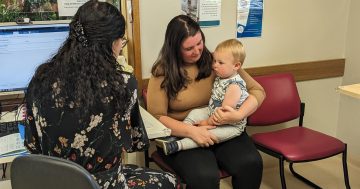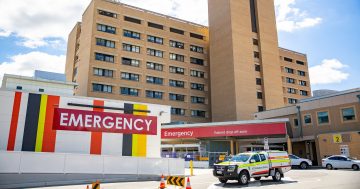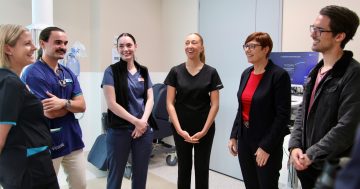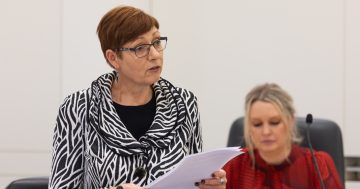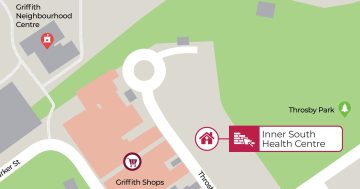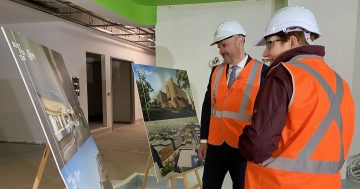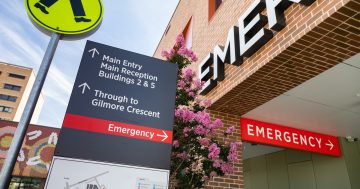
Dr Kerryn Coleman. Photo: Dominic Giannini.
The ACT will start moving away from emphasising the number of people who have been in the community while infectious as vaccination rates continue to rise.
The proportion of people who have been infectious in the community has plateaued, but more than half of the ACT’s 125 cases in the past week were in the community for at least part of their infectious period.
More than 50 per cent of people above the age of 12 are fully vaccinated in the ACT, and three in four people have had at least one dose.
After more than five weeks in lockdown, health authorities now have the data to be able to confidently classify cases who were in the community as low risk, which means there would not be a need to list some locations as exposure sites, Chief Health Officer Dr Kerryn Coleman said.
“As we move forward, what will become more relevant is what of these [cases] are low risk and what of these are high-risk opportunities, and we really have not done that yet,” she said.
“We are really now getting comfortable with our lower risk classification. We have got to a stage now where we can be confident saying, for these people and these cases, they are low risk because these are the activities and the precautions they have taken.
“For example, we are now reasonably confident that essential workers in certain settings, wearing a mask all the time, can be classified as low risk, so therefore, there may come a phase in the future where we will not classify that site as a potential exposure site.”
While concern remains on the number of asymptomatic cases in the community who may infect others unwittingly, Dr Coleman said fully vaccinated people and those who were asymptomatic were less likely to transmit the virus.
This is due to the reduced viral load associated with asymptomatic cases and the absence of transmission risks like sneezing and coughing.
Dr Coleman confirmed that there are currently seven active public sites of transmission.
“That is a transmission we are looking to make as we progress through. It is also really important for us to understand where the spread or transmission is occurring so we can focus efforts on reducing that,” she said.
“It may be challenging … to get to zero [people infectious in the community]. The aim is that we will not need to do that when we get to the higher levels of vaccination coverage.”
Dr Coleman could not pinpoint a level of vaccination coverage that would enable health authorities to feel confident enough to reduce their focus on the number of infectious people in the community.
Health Minister Rachel Stephen-Smith said vaccination rates needed to be considered alongside the Territory’s capacity to test, trace, isolate and quarantine cases (TTIQ) once restrictions begin to ease.
“One of the things that is really clear in the Doherty modelling is you need to consider your vaccination rate alongside your capacity to maintain TTIQ measures and then look at what public health and social measures you need to put in place to balance all of that to maintain a manageable level of case numbers so you do not overwhelm your health system,” she explained.
“The more cases we have and the more people who are potentially infectious in the community, the more pressure you then put on your contact tracing team and your case investigation team.”
The next lockdown checkpoint will be on 1 October, halfway through the one-month extension that is due to end of 15 October.
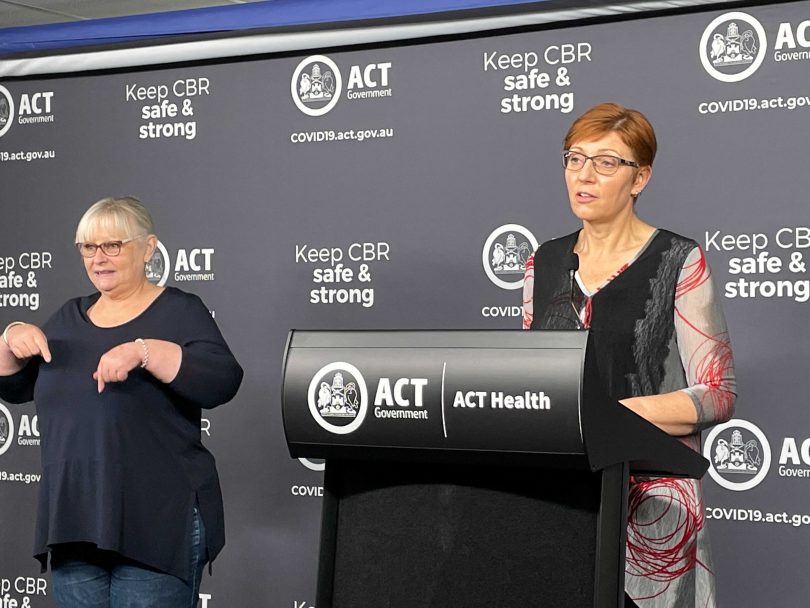
Health Minister Rachel Stephen-Smith delivering this morning’s COVID-19 briefing. Photo: Dominic Giannini.
UPDATED 12:30 pm: There are 17 new cases of COVID-19 in the ACT overnight, 11 of which are linked to known cases, including 10 household contacts.
Five cases were in quarantine, but 12 spent some of their infectious period in the community. Two patients are in intensive care and eight are hospitalised.
Chief Health Officer Dr Kerryn Coleman told today’s press briefing that the outbreak now totals 618 with 242 active cases. Exposure locations are expected to increase sharply this afternoon and this evening following the higher numbers in recent days.
But Dr Coleman said that there are no new active sites of transmission, and none of the new cases are linked to existing sites, an emerging trend. There are now seven active public transmission sites and the significant majority of new cases are household contacts.
“I think as we identify exposure sites, the more we’re seeing casual and not close contact sites,” Ms Stephen-Smith said.
“The less transmission we see at public sites is obviously a good thing, but we have a lot of people in the community still moving around doing essential work. The nature of Delta is that some people will have gone to work while unknowingly infectious.
“What we see with cases continuing to plateau and not trending upwards is a positive sign for us, but we’ll continue to see cases because that’s the nature of the Delta variant”.
In the ACT, 2992 tests were carried out yesterday.
Ms Stephen-Smith said this was not a bad result for a Saturday when testing tends to drop off, but people must continue to come forward as close or casual contacts, or if any symptoms present, including fever, coughing, sore throat, shortness of breath, loss of smell or taste, and a runny or blocked nose.
Yesterday, 82 traffic stops were carried out and there were two directions to leave the territory. There were compliance checks on 29 businesses.
Ms Stephen-Smith said that while recent compliance breaches on residential construction sites were “extraordinarily disappointing”, the government was comfortable with the decision to re-open the sector. Some sites, particularly those associated with peak bodies, had excellent advice and strong COVID-safe plans in place.
She added that transmission had not necessarily taken place on building sites, but all forms of essential work posed some risk. Visitors to the site could be a risk and as Victoria had identified, workers often travel considerable distances risking geographic spread.
Vaccinations for 12 to 15-year-olds open tomorrow at the ACT’s mass vaccination clinics. There are around 25,000 people in this cohort in the ACT. The next appointments at government clinics are not available until mid-October so the fastest booking may be through a GP or pharmacy, which will soon have Moderna vaccines.
From tomorrow (20 September), the daily reporting will show the percentage of people 12 and over who are vaccinated rather than the 16-plus population so vaccination rates will temporarily drop a little as a result.
Ms Stephen-Smith also highlighted ongoing restrictions at health care facilities, where nobody is permitted to enter without an exemption. These are granted where patients are critically ill, at end of life, for birthing or paediatric care, or because a patient requires significant care because of a disability or special needs.
COVID-safe measures are in place for all permitted visitors and Ms Stephen-Smith said hospital staff understood the need for social connection and were working to ensure that wherever possible.
UPDATED 11:55 am: The ACT has recorded 17 new COVID-19 cases in the 24 hours to 8:00 pm last night.
Yesterday, 15 new cases were reported.
Eleven of the new cases are linked to known cases and six are under early investigation.
Five were in quarantine for the entirety of their infectious period. Twelve spent some of their infectious period in the community.
Eight people are in hospital with COVID-19, two are in intensive care and one person requires ventilation.
There were 2992 tests yesterday. Health Minister Rachel Stephen-Smith, who conducted this morning’s briefing, said it was “not a bad number for a Saturday”.
Compliance activities have continued. There were 82 traffic stops yesterday and two directions to leave the ACT.
NSW has recorded 1083 new cases, and 13 people have died with the infection in the 24 hours to 8:00 pm last night.
Yesterday, NSW recorded 1331 new cases and six deaths.
Victoria has recorded 507 cases and one death. Yesterday there were 535 new infections and one death.
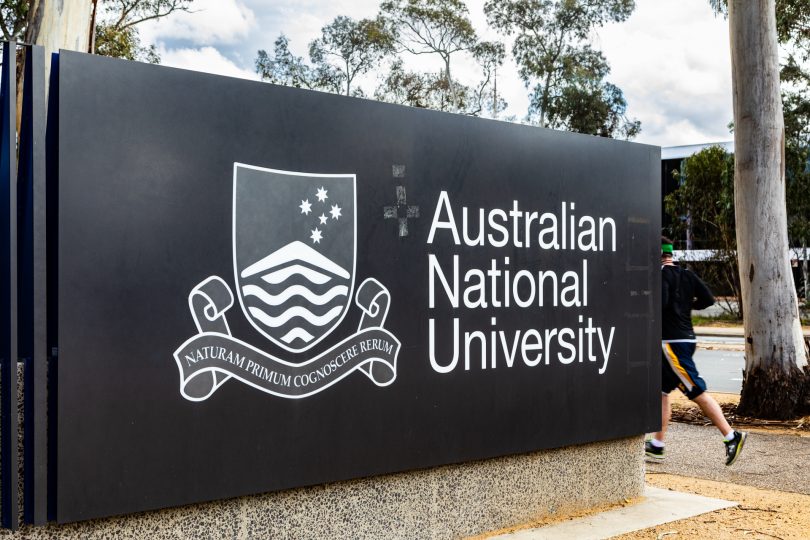
The Australian National University’s Oliphant building has been listed as an exposure site. Photo: Michelle Kroll.
A Red Hill construction site, a building at the Australian National University (ANU) and a number of public transport routes have been listed as exposure locations overnight.
Anyone at the Yarra Rossa construction site on Hicks Street between 7:00 am and 4:00 pm on Tuesday and Wednesday (14 and 15 September) or between 7:00 am and 10:30 am on Thursday is considered a casual contact.
A second worksite in Manuka at the Renaissance on Light Street has also been listed as a casual exposure site between 7:20 am and 1:00 pm on Saturday (11 September).
Anyone at the Oliphant Building at ANU between 8:50 am and 1:15 pm on Tuesday (14 September) is considered a casual contact.
Busy Bees early learning centre at Crace has again been named a casual contact site, this time between 8:45 am and 2:30 pm on Wednesday (16 September).
Five public transport routes, including the Route 3 bus from the Belconnen to the city interchange, the Route 4 bus between the Woden and city interchange and the light rail have also been listed as casual exposure sites across Saturday, Sunday and Monday (11 to 13 September).
Supermarkets in Weston Creek, Wanniassa, Hughes, Kambah, Kippax, Crace, Melba, Wason, Belconnen and East Row in the city have also been listed as exposure locations.
The complete list of exposure locations is available at www.covid19.act.gov.au.
Health Minister Rachel Stephen-Smith and Chief Health Officer Dr Kerryn Coleman will update the ACT’s COVID-19 situation at 11:45 am.
More to come.












